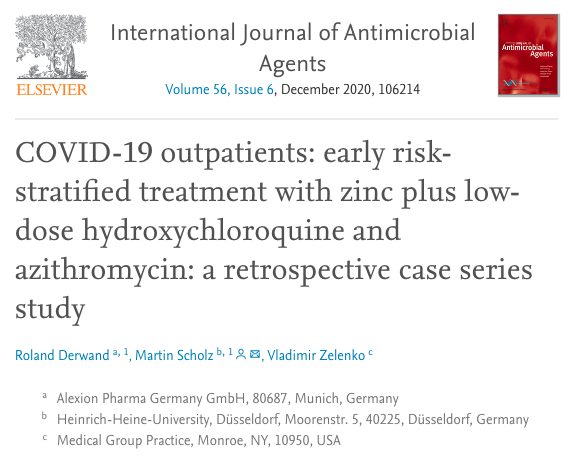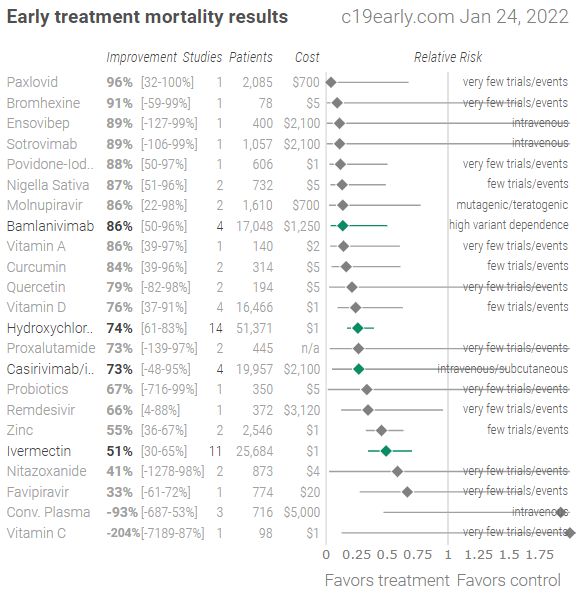Dr Vladimir Zelenko Hydroxychloroquine Regimen Protocol for COVID-19
The original Zelenko protocol consists of zinc, low-dose hydroxychloroquine and azithromycin (Zithromax). Based on rapidly emerging clinical trials evidence of ivermectin, an anti-parasitic medicine, has highly potent real-world, anti-viral and anti-inflammatory properties against COVID-19 virus, Dr Zelenko has also included ivermectin as part of his prevention and treatment protocols.
Zelenko Covid-19 Prophylaxis Protocol
- Low Risk Patients: Young healthy people do not need prophylaxis against Covid-19. In young and healthy people, this infection causes mild cold-like symptoms. It is advantageous for these patients to be exposed to Covid-19, build up their antibodies and have their immune system clear the virus. This will facilitate the development of herd immunity and help prevent future Covid-19 pandemics. However, if these patients desire prophylaxis against Covid-19, then they should take the protocol noted below.
- Moderate Risk Patients: Patients from this category are healthy but have high potential viral-load exposure. This group includes medical personnel, caregivers of high-risk patients, people who use public transportation, first responders and other essential personnel who are crucial to the continued functioning of society. These patients should be encouraged to take prophylaxis against Covid-19 in accordance with the protocol noted below.
- High Risk Patients: Patients are considered high risk if they are over the age of 45, or if they are younger than 45 but they have comorbidities, that is, they have other health conditions that put them at risk. These patients have between a 5 to 10% mortality rate if they are infected with Covid-19. These patients should be strongly encouraged to take prophylaxis against Covid-19 in accordance with the protocol noted below.
- Zinc (elemental) 25mg 1 time a day (PubMed) (Amazon) (iHerb)
- Vitamin D3 5000 iu 1 time a day (vdnmeta.com) (Amazon) (iHerb)
- Vitamin C 1000 mg 1 time a day (PubMed) (Amazon) (iHerb)
- Quercetin 500mg 1 time a day (Amazon) (iHerb)
- Hydroxychloroquine (HCQ) 200mg once a day for 5 days, then HCQ 200 mg one time a week (ScienceDirect) (Find a Doctor)
- Vitamin D3 5000 IU/day for 5 days (Amazon)
- Zinc 25 mg/day (Amazon) | How much zinc to take with hydroxychloroquine?
- Although ivermectin and hydroxychloroquine (HCQ) are relatively safe drugs, they are still synthetic chemicals that can have side effects. Vitamin D, C, Zinc and Quercetin are nutrients that your body require for optimal health. Nutrients are safer alternatives especially if your risk is low e.g. age below 50 and no other chronic illness. Discuss with your doctor on the benefit vs risk for each treatment.
- Some 200 peer-reviewed studies (C19Study.com) by government and independent researchers deem HCQ safe and effective against Coronavirus, especially when taken prophylactically or when taken in the initial stages of illness along with zinc and azithromycin. Unfortunately, some of the RCTs that have been conducted to date used toxic doses of HCQ and/or were given very late in the disease.
- Inorganic zinc such as zinc sulfate, is not as effective or useable by your body as chelated zinc sources. Zinc lozenges are preferred so that the tissues of the nose and throat are rich in zinc as soon as they encounter the virus
Zelenko Protocol - Treatment Plan for Patients with Covid-19 symptoms
Fundamental Principles (Dr Zelenko Protocol When to Start)
Patient Categories
Low risk patient - Younger than 45, no co-morbidities, and clinically stableHigh risk patient - Older than 45, younger than 45 with co-morbidities, or clinically unstable
Treatment Options
Low risk patients - over the counter options:
Alternative for Quercetin: Epigallocatechin-gallate (EGCG) 400mg 1 time a day for 7 days (J. Agric. Food Chem) (Amazon)
- Zinc (Elemental) 50-100mg once a day for 7 days
- Vitamin C 1000mg 1 time a day for 7 days
- Vitamin D3 10,000 iu once a day for 7 days or 50,000 iu once a day for 1-2 days
- Azithromycin (Z Pack) 500mg 1 time a day for 5 days (Clin Drug Investig) OR Doxycycline 100mg 2 times a day for 7 days
- Hydroxychloroquine (HCQ) 200mg 2 times a day for 5-7 days (ScienceDirect)
Ivermectin 0.4-0.5mg/kg/day for 5-7 days (ivmmeta.com). (Find a Doctor)
Hydroxychloroquine and ivermectin combined? Either or both HCQ and IVM can be used, and if one only, the second agent may be added after about 2 days of treatment if obvious recovery has not yet been observed etc.
If HCQ is not available, Quercetin 500mg 3 times a day for 7 days OR
EGCG 400mg 2 times a day for 7 days
- Dexamethasone 6-12mg 1 time a day for 7 days OR Prednisone 20mg twice a day for 7 days, taper as needed (not suitable during viral phase)
- Budesonide 1mg/2cc solution via nebulizer twice a day for 7 days (not suitable during viral phase)
- Blood thinners (i.e. Lovenox, Eliquis, Xarelto, Pradaxa, Aspirin) (Amazon)
- Colchicine 0.6mg 2-3 times a day for 5-7 days (MedRxiv 2021)
- Monoclonal antibodies
- Home IV fluids and oxygen
- Curcumin: 500 mg twice a day (Ref) (Amazon)
- Fluvoxamine: 50 mg twice daily for 10–14 days. Add to ivermectin if: 1) minimal response after 2 days of ivermectin; 2) in regions with more aggressive variants; 3) treatment started on or after day 5 of symptoms or in pulmonary phase; or 4) numerous co-morbidities/risk factors. Avoid if patient is already on an SSRI (selective serotonin reuptake inhibitor).
- If you can’t get fluvoxamine (Luvox), using 30mg once a day of fluoxetine (Prozac) is equally effective (equivalent to 50mg twice a day of fluvoxamine).
- Pulse Oximeter: Monitoring your oxygen saturation with a pulse oximeter and to go to the hospital if you get below 94%. (Amazon)
- Mouthwash: 3 x daily – gargle (do not swallow) antiseptic mouthwash with cetylpyridinium chloride (e.g. Crest, Scope mouthwash™), ListerineTM with essential oils, or povidone/iodine 1 % solution as alternative (Betadine® Antiseptic Sore Throat Gargle™). (Ref)
- Nasal Spray: Xlear Nasal Spray with Xylitol (Ref) (Amazon)
- Aspirin: 325 mg/day unless contraindicated. (Amazon) (not suitable during viral phase)
- Bromhexine 8 mg three times a day (Ref) (Lazada Malaysia*)
- Precautionary Note: Ivermectin has a number of potentially serious drug-drug interactions. Please check for potential drug interaction at Ivermectin Drug Interactions - Drugs.com. The most important drug interactions occur with cyclosporin, tacrolimus, anti-retroviral drugs, and certain anti-fungal drugs.
- Due to the possible drug interaction between quercetin and ivermectin (may increase ivermectin levels), these drugs should not be taken simultaneously (i.e. should be staggered morning and night).
- Ivermectin is also lipophilic and therefore, bioavailability is maximised on a full stomach; or best to be taken with meal.
- Vitamin D3 RDA (Recommended Daily Allowance) is 800–1000 IU/day. The safe upper-dose daily limit is likely < 4000 IU/day. Be aware that most of the 'treatment' dosages for nutrients are above the recommended dietary allowance (RDA) and therefore such dosages should not be maintained on a long term basis.
- Vitamin D deficiency has been associated with an increased risk of acquiring COVID-19 and from dying from the disease. Vitamin D supplementation may therefore prove to be an effective and cheap intervention to lessen the impact of this disease, particularly in vulnerable populations, i.e. the elderly and obese.
- When Is the Best Time to Take Vitamin D? Morning or Night? It is possible that increasing vitamin D levels during the day may act, in part, as a signal that suppresses melatonin generation (source). Therefore, it's better to take vitamin D (with meal) during the day and melatonin to be taken just before bedtime.
- It is likely that vitamin C and quercetin have synergistic prophylactic benefit. Quercetin should be used with caution in patients with hypothyroidism and TSH levels should be monitored.
- Please consult with a qualified doctor and only use human ivermectin. Ivermectin for animals contain excipients (binding and storage compounds such as polyethylene glycol (PEG)) that are known to cause liver failure in high doses.
Hydroxychloroquine and COVID-19
Hydroxychloroquine, developed in the 1950s from chloroquine, an old anti-malarial drug, is registered in around 60 countries under trade names such as Plaquenil, Quensyl and Plaquinol.
Hydroxychloroquine, I-MASK Protocol and McCullough Protocols
Hydroxychloroquine is also part of various early treatment protocols including the latest FLCCC I-MASK+ protocol and Peter McCullough protocol.
About Dr Vladimir Zelenko
When asked about studies that seemed to discredit the efficacy of HCQ in treating the Chinese coronavirus, Zelenko explained “You don’t fire a gun without a bullet in it and then say the gun doesn’t work when you don’t kill the target. The studies that were done on HCQ did not include the use of Zinc. HCQ is what opens the cell and enables Zinc to attack the virus. One is not effective without the other, or without a suitable substitute for HCQ. The studies were designed to fail.”
Dr. Zelenko says that both prophylaxis measures and actual case treatments need to be customized to the individual. As a general rule, he says, those people who are in the higher risk groups, both by age and by other pre-existing conditions, require more aggressive actions on both the preventative and diagnostic side.
“This virus remains relatively stable inside the host for about the first five days,” Zelenko says. “After that it starts to multiply rapidly. It also starts to migrate from sinus to lungs and cardio areas where involvement becomes more severe and treatment becomes more difficult. The key is early intervention.” Zelenko again mentioned his 84% success rate in high-risk patients.




.png)

.png)




.jpg)
Comments
Post a Comment